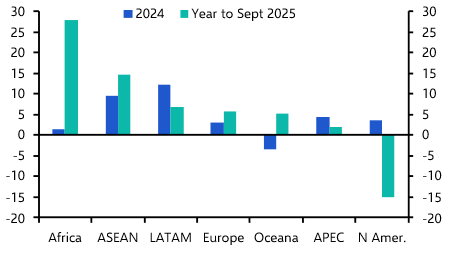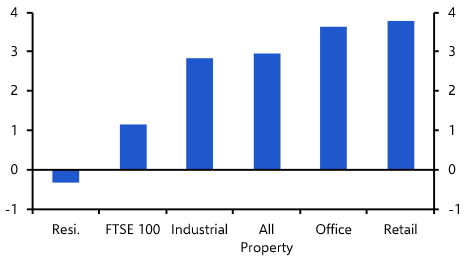In my final note of 2020, I made the case for expecting a strong rebound in most economies this year. That inevitably led to questions about what might derail our above-consensus forecasts – and those questions have come into sharper focus following the recent surge in virus cases in the UK, and the extension of restrictions there and in parts of Europe and Japan.
It’s now standard for economists to attach a long list of “key risks” to their “key calls” for the year ahead. The experience of the past year reveals how narrow our horizons tend to be when thinking about these risks. Nobody (including us) anticipated that in 2020 a pandemic would lead to the biggest fall in global GDP since World War Two. That does not mean that forecasts are worthless – just that we need to accept the nature of forecasting is uncertain and some events are simply unknowable before they happen.
In that spirit, it would be easy to reel off a long list of shocks – from natural disasters to wars – that could derail the global rebound we are anticipating this year. But doing so would be of little value to clients unless we believed there was a reasonable chance of these risks materialising.
Instead, I think it is more useful to separate risks between those rooted in conventional macroeconomics and those related to the evolution of the pandemic and the fight against it.
The prospect of a sudden rise in inflation – and an associated policy response by central banks – ranked towards the top of most surveys of key risks going into this year. Inflation is likely to rebound over the coming months, as the effects of last year’s sharp falls in energy prices and, in some cases, indirect tax cuts unwind. But we expect central banks to look through this and do not anticipate a significant pick-up in core inflation in 2021.
And while we think there is a growing possibility that underlying inflation pressures will start to build in some countries (notably the US) beyond this year, this is because policymakers may take a conscious decision to allow economies to “run hot” and accept a moderately higher rate of inflation as a price worth paying to achieve other policy goals. If so, this would have fundamentally different consequences for asset prices compared to a period of higher inflation caused, for example, by continuing supply-side restrictions.
A different but related risk is that ultra-loose monetary policies lead to a misallocation of capital that ultimately threatens the stability of the financial system in one or several major economies. Once again, this is plausible – history shows that a combination of easy money and liberalised capital markets can cause asset price bubbles to inflate, which can then cause economic and financial market dislocation when they burst. But this process typically plays out over years, not months. While it’s worth keeping at least one eye on China’s property market, we think that the valuation of major asset classes (including equities) can for now be justified in the context of lower interest rates. What’s more, where pockets of froth do exist, such as in Bitcoin, we do not believe this poses a systemic threat to the global financial system.
Instead, a more immediate risk is that policymakers either withdraw support or tighten policy prematurely, thus snuffing out the economic rebound we anticipate. The good news is that there is now almost universal agreement among governments and central banks over the need to maintain fiscal and monetary support until recoveries are entrenched. But a fraying of this consensus would pose a significant threat to our more upbeat economic forecasts.
Related to this, a key concern for financial markets is not necessarily that the consensus itself starts to fracture but that policymakers signal that it might. It is not difficult to envisage how one misplaced comment about inflation risks from a central banker could cause a sharp sell-off in government bond markets.
In truth, though, the biggest risks to our more upbeat economic forecasts for this year relate to the evolution of the pandemic and efforts to fight it. Our optimism for 2021 assumes that the rollout of vaccines will allow restrictions to begin to be lifted by Q2, and that the subsequent recovery in activity will be supported by a rundown in private savings that have been accumulated over the past year.
But there are several risks to this view. The most immediate is that the rollout of vaccines is slower than we anticipate, held back by bottlenecks in production or, more likely, distribution and administration. Further out, there is a risk that the virus mutates in a way that makes the current vaccines less effective. While scientists believe they should be able to adapt the vaccines in response to changes in the virus, this could require a second round of mass vaccinations and the reimposition of some lockdown measures while this happens. Indeed, even with a rapid rollout of vaccines, it is possible that, mindful of the pressure on healthcare systems, governments decide to roll back the current restrictions on activity more slowly than we currently anticipate.
The history of the pandemic so far has been one of hope trumping experience, with governments anticipating that lockdowns will be short-lived but then retreating as the virus spreads in ways that we failed to envisage. This makes for perilous terrain for forecasters. There remain good reasons to believe that, after a difficult Q1, the economic outlook will brighten over the second half of the year. But if we are wrong, it is likely to be because the virus has once again confounded us all.
In case you missed it:
- Our Senior Europe Economist, David Oxley, examines the rollout of vaccines in Europe and the implications for the region’s economy.
- Our Senior US Economist, Michael Pearce, assesses the economic and fiscal implications of the last week’s Senate run-off.
- Our markets team argue that the reflation and rotation trade in risky assets has further to run.



